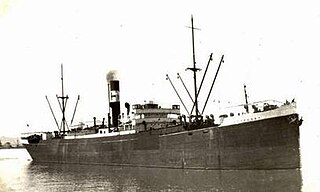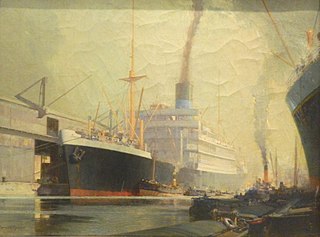
SS Clan Macwhirter was a British cargo steamship. She was built in 1918 as Ypresville in the First World War and sunk by enemy action in 1942 in the Second World War. In her 24-year career she also carried the names Halizones and Willcasino.
SS Assyrian was a cargo ship that was built in Hamburg for German owners in 1914, transferred to British owners in 1920 as war reparations and sunk by a U-boat in 1940. She was launched as MS Fritz, and when she changed owners in 1920 she was renamed MS Assyrian. She had been built as a motor ship but in 1925 she was converted to a steamship and became SS Assyrian.
SS Beatus was a British cargo steamship that was built in 1925, sailed in a number of transatlantic convoys in 1940 and was sunk by a U-boat that October.

SS Somersby was a British cargo steamship that was built in 1930, sailed in a number of convoys in the Second World War and was sunk by a U-boat in 1941.

SS Soesterberg was a Dutch-owned cargo steamship that was built in Belgium in 1927 and sunk by a U-boat in 1940 in the Battle of the Atlantic.

SS Fiscus was a UK cargo steamship that was built in 1928, served in the Second World War and was sunk by a U-boat in 1940.

SS Scoresby was a British cargo steamship that was built in 1923, sailed in a number of transatlantic convoys in 1940, and was sunk by a U-boat that October.

SS Sarpedon was a UK steam turbine passenger and refrigerated cargo liner launched in 1923. She was the fourth of six ships to bear the name.
SS Tregenna was a cargo steamship that was launched in England in 1919 and sunk by a U-boat in the Battle of the Atlantic in 1940 with the loss of 33 of her 37 crew. She was laid down as War Bulldog, but the Hain Steam Ship Co bought her before she was completed and renamed her Tregenna.
SS Canonesa was a refrigerated cargo steamship that was built in Ireland in 1920 and sunk by a u-boat in the Atlantic Ocean in 1940.
SS Yoma was a British passenger liner that served as a troop ship in the Second World War. She was built in Scotland in 1928, and from then until 1940 Yoma ran a regular route between Glasgow in Scotland and Rangoon in Burma via Liverpool, Palma, Marseille and Egypt. She became a troop ship in 1941 and was sunk with great loss of life in the Mediterranean in 1943.

SS Oropesa was a British steam turbine ocean liner of the Pacific Steam Navigation Company (PSNC). She was built on Merseyside in 1920 and operated between Liverpool and South America. In 1941 the German submarine U-96 sank her in the Western Approaches, killing 106 people aboard.
SS Umona was a British cargo liner. She was built at Sunderland on the River Wear in 1910, survived the First World War and was sunk by enemy action off Sierra Leone, West Africa in 1941.
SS City of Bedford was a British cargo steamship. She was launched in 1924 in Sunderland for Hall Line Ltd of Liverpool, a member of the Ellerman Lines group.
SS Llanashe was a UK cargo steamship. She was launched in 1936 in Sunderland, England, and sunk by a U-boat in the Indian Ocean in February 1943.
SS Jumna was a steam passenger liner that was built in Scotland in 1929 and sunk with all hands by a German cruiser on Christmas Day 1940. She was a ship in the fleet of James Nourse, Ltd, whose trade included taking indentured labourers from India to the British West Indies.
SS Tregarthen was a cargo steamship that was built in Scotland for the Hain Steam Ship Co in 1936. She was sunk with all hands by a U-boat in 1941 in the Battle of the Atlantic.
HMS Crispin was a British cargo steamship that was launched in England in 1934 and operated by Alfred Booth and Company between Liverpool and the east coast of South America. In 1940 the British Admiralty requisitioned her and had her converted into an ocean boarding vessel. In 1941 a U-boat sank her in the Battle of the Atlantic, killing 20 of her crew.
SS Pennington Court was a British cargo steamship. She was launched in 1924 as Rochdale and renamed Pennington Court in 1927. In the Second World War she carried iron ore, grain and other supplies to Britain. She was sunk with all hands in the Battle of the Atlantic in 1942.
SS St. Elwyn was a cargo steamship that was built in England in 1938 and owned by the South American Saint Line. A German U-boat sank her in the Atlantic Ocean in 1940, with the loss of 24 of her crew.








